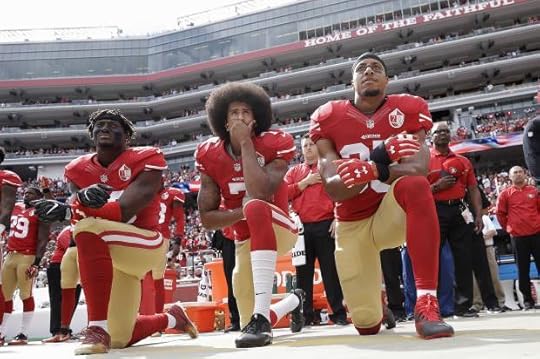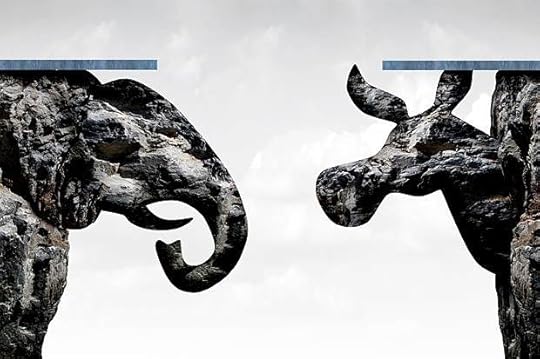Helen H. Moore's Blog, page 329
August 16, 2017
Is the Trump administration “turning a blind eye” to Louisiana’s storm season?

(Credit: Getty/Harvepino)

It’s been over six months since Donald Trump became President of the United States, and the new administration and agencies have yet to get on their feet.
And for Louisiana in particular, the lack of federal aid and hurricane response leaders (which agencies are still scrambling for) has chipped a subtle crack between the state’s unwaveringly loyal congressional delegation and increasingly fatigued locals.
The Federal Emergency Management Agency (FEMA) only swore in its permanent head, previous Alabama emergency response agency director Brock Long, in June — just as hurricane season was underway and residents’ anxieties were elevating. But storms and flooding are in the back of Louisiana’s mind year-round; Hurricane Katrina’s shadow still looms, and many areas remain fragmented from last year’s historic floods that mainly destroyed low-income households and resulted in failing grades for FEMA in statewide polls. Officials predict an abnormally intense few months, with up to 19 named storms and five major hurricanes. This month, areas of New Orleans suffered nine inches of rain in a matter of hours due to failed drainage pumps, prompting school closures and a declarative state of emergency this week.
Before the season began, Baton Rouge Mayor-President Sharon Weston Broome said she wanted to see permanent federal leadership at FEMA. Nearly 2,000 families in East Baton Rouge Parish, one area hard-hit by the historic August 2016 flood, still live in the manufactured housing units provided by FEMA at the beginning of this hurricane season, according to an agency spokesperson. Broome said the units are not meant to withstand high winds.
The unusually prolonged lack of key agency leaders has been a countrywide contention point in American politics. Long’s swearing in came 140 days into Trump’s presidency, which one state senator called “inexcusable.”
FEMA isn’t the only disaster protection agency under pressure. The National Oceanic and Atmospheric Administration (NOAA), which directs weather forecasting and the National Hurricane Center, has also been without a permanent leader since Trump’s inauguration.
Some Republican lawmakers blame the lack of agency heads on Democrats for blocking presidential appointments — something freshman U.S. Rep. Mike Johnson,R-La., in June called “bitter partisan fights between every issue under the sun.”
Partisanship in natural disasters also infects federal-state relationships, particularly with Louisiana Gov. John Bel Edwards, the outnumbered, lone Democratic governor in the Gulf South who said in May that Trump’s budget “turns a blind eye” to his state, in part because it pulls hurricane protection funds.
The governor petitioned for $3.6 billion in federal disaster aid a year ago after the August 2016 flood. He has only received $1.7 billion in disaster aid so far, and Rep. Ralph Abraham, R-La., blames Edwards for the slow progress.
Abraham said the rest will come once Louisiana shows it’s handling its first allocation, which the governor has just begun distributing to flood-affected homeowners this summer. The federal money became available to spend and the application process began in April — months after it was originally asked for.
“We still have people from March [2016] living in hotel rooms, shelters [and] with relatives,” Abraham said in June. “They’ve been hurting.”
In fact, 57 out of Louisiana’s 64 parishes — 89 percent of the state population — is still in some sort of recovery from natural disasters since March 2016, according to the state’s Department of Children and Family Services. As of last week, about 1 percent of the Congressional appropriation was reportedly dispersed to affected residents.
Receiving federal aid in fragments is normal. But overall, Trump’s disaster aid package to Louisiana is unlike any the Louisiana governor can remember — mostly because it is the first that does not grant infrastructure aid, which would help prevent similar losses in future disasters. After Congressional appropriation, HUD has only given Louisiana enough disaster aid money so far for housing and an inadequate amount for infrastructure. The Trump budget proposal calls for eliminating future disaster aid funds, called Community Development Block Grants, entirely.
Louisiana did in July get a hefty gift — hundreds of millions of dollars — from FEMA for future flood prevention, which is separate from the infrastructure-starved aid package from Congress. The governor estimates the state needs more than three times as much of that money for future storm resiliency alone, which locals are still looking to their Washingtonian representatives to shore up. But FEMA programs are also slashed in Trump’s budget proposal, suffering hundreds of millions in cuts.
While the Trump administration has yet to see the kind of billion-dollar disaster that previous presidents have, Gov. Edwards and HUD Secretary Ben Carson met in person Tuesday to discuss removing certain federal regulations that slow down allocation. But some are not even looking to the federal government this hurricane season.
“A lot of times, the [federal] response is very lacking,” said state Sen. Bret Allain, R-Franklin, in June, as his state braced itself for another prayerful storm season under sea level. But the state takes pride in its resiliency: “If we don’t get help, we usually tend to take care of ourselves.”
At the time, Congressmen in Washington agreed. “If the Sheriff doesn’t come to work, guess what?” said Rep. Clay Higgins, R-La. “We still arrest people.”
Martin Shkreli thinks he’ll be president someday

(Credit: AP Photo/Seth Wenig)
Do you think Martin Shkreli, aka the “Pharma Bro,” is destined to become an American president?
If you don’t, he certainly does.
“Well, at some point I’ll be POTUS,” Shkreli wrote on his Facebook page in a post published Tuesday. He added that conservative commentator Ben Shapiro would be his vice president and alt-right pundit Milo Yiannopoulos would be his press secretary, before going on to list some more unorthodox choices:
Kanye West will be head of the CIA. Stefan Molyneux will be Secretary of State. Kodak Black will be Attorney General. Edward Snowden would be the head of the NSA. Julian Assange: FBI. Kim Kardashian is Fed Chairwoman. Trashy is Surgeon General.
From there, Shkreli predicted defeating a ticket with President Mark Zuckerberg and Vice President Bernie Sanders no earlier than 2024, since he also predicted they’d have to abolish Zuckerberg’s Universal Basic Income “which passed in 2024.”
Shkreli added that Young Turks host Cenk Uygar “will be sent back to wherever he came from” and that “Lauren Duca will tragically fall ill from subtweeting too hard if she isn’t the First Lady.”
Somewhat more ominously, Shkreli also boasted that he would put nuclear weapons in enemies’ cities, force members of the media to go through “training programs” and completely slash “almost all entitlement programs.”
An account purportedly belonging to Yiannopoulos has already liked the status update and said that “I’m down,” while Shkreli added in the comments that “OKAY FINE KIM KARDASHIAN WILL BE HEAD OF THE FEDERAL RESERVE.”
Whereas President Donald Trump at least had a core of support prior to his career as a politician, Shkreli may now be best known for raising the price of a life-saving drug by 5000 percent and being convicted of three counts of securities fraud.
Donald Trump’s CEO advisory councils are done, but who eliminated them?

Jeff Bezos, Larry Page, Sheryl Sandberg, Mike Pence, Donald Trump and Peter Thiel meet at Trump Tower in New York, December 14, 2016. (Credit: Getty/Timothy A. Clary)
President Donald Trump is picking up his marbles and taking them home.
After five members of a manufacturing advisory council resigned this week over the president’s reaction to a hate rally that turned deadly in Charlottesville, Trump decided he didn’t want to play with them anymore.
In a surprise message announced on his Twitter account, the president abruptly ended an initiative to garner advice from the heads of well-known companies through two groups, one to discuss how to create factory jobs and the other to tackle economic policies.
Rather than putting pressure on the businesspeople of the Manufacturing Council & Strategy & Policy Forum, I am ending both. Thank you all!
— Donald J. Trump (@realDonaldTrump) August 16, 2017
The timing of the decision raised questions about whether Trump decided to end his initiatives before facing further embarrassment of executives reacting to his policies and statements by distancing themselves from the White House.
The president only met once publicly with members of the Strategic and Policy Forum, back in February. But if you missed it, don’t worry. Little has come from either of the groups since they were formed, and no formal policy announcement has been made attributable to them.
Another question: Who actually decided to disband the larger Policy Forum? CNBC reported Wednesday that the members of the board itself decided to disband, citing the president’s unpredictable behavior. Less than two hours before Trump’s tweet announcing he was disbanding the two groups, he expressed frustration at the CEOs who dropped, calling them “grandstanders” that force him to seek replacements.
For every CEO that drops out of the Manufacturing Council, I have many to take their place. Grandstanders should not have gone on. JOBS!
— Donald J. Trump (@realDonaldTrump) August 15, 2017
On Monday, the president lashed out at Kenneth Frazier, the CEO of drugmaker Merck, for resigning from the council after the president blamed “many sides” for the violence that erupted Saturday. Trump attacked Frazier, who is African-American, for ripping off Americans on drug prices.
Now that Ken Frazier of Merck Pharma has resigned from President's Manufacturing Council,he will have more time to LOWER RIPOFF DRUG PRICES!
— Donald J. Trump (@realDonaldTrump) August 14, 2017
Earlier this year, Disney CEO Bob Iger and Elon Musk, the heads of Tesla and SpaceX, respectively, departed in protest of the president’s move to pull out of the global Paris Agreement on climate change. In February, Uber’s then-CEO Travis Kalanick backed out after Trump initiated a ban on travelers from eight Muslim-majority countries.
The manufacturing council was announced by the White House in January as a way for the president to meet with “some of the world’s most successful and creative business leaders to share their experiences and gain their insights.” The group was created to give advice to the president on how to create more factory jobs, but so far little had come from group beyond the usual private-sector and Republican drumbeat of tax cuts and deregulation.
The Strategic Policy Forum, headed by billionaire investor Stephen A. Schwarzman, was created in December to guide Trump in his overall strategy of running the government like a private enterprise, something the president has said is the way to create jobs and drive economic growth.
These two groups offered CEOs and private investors special access to lobby directly into the president’s ear. But some members realized that the price in reputation for that access was too high.
Neo-Nazi blog The Daily Stormer tries to move to Russian domain

(Credit: Getty/Chip Somodevilla)
An American neo-Nazi website has taken a cue from Donald Trump Jr. by looking to Russians for help.
Less than a day after The Daily Stormer went dark, Ars Technica reported the notorious hate-centric website was up and running again Wednesday, this time using the Russia-based domain dailystormer.ru.
On Monday, Google suspended the site from its domain name service (DNS) almost immediately after the Nazi blog was evicted by its long-time domain provider, GoDaddy. This means that the blog could no longer use the coveted “.com” top-level domain. According to Andrew Anglin, The Daily Stormer’s creator, Google has refused to allow him to change his dailystormer.com registration to another company.
After being shut out of his regular .com domain, Anglin and his technology adviser, Andrew “Weev” Auernheimer, moved the site to dailystormer.wang. “.wang” is a top-level domain which normally caters to Chinese-language websites. Yet within hours, the site was suspended again.
In the interim, Auernheimer migrated the site to Tor, an anonymous peer-to-peer network, sometimes referred to as the “dark web,” that is inaccessible without special software. Finally, The Stormer was registered through a Russian domain service, meaning it is easy to visit on the “normie internet,” as Auernheimer described it.
The site’s new registrar, a private company called Ru-Center, is Russia’s largest domain name and web hosting provider.
Throughout all of this domain-hopping, the Nazi blog relied on security and protection services from Cloudflare, an internet security firm that has come under fire from activists for protecting terrorist and hate groups who enlist Cloudflare’s services.
On Wednesday afternoon, however, Anglin announced that the Daily Stormer had been suspended by Cloudflare as well — leaving the site open to denial-of-service attacks from anti-Nazi hackers who have long wanted to target it. Previously, with Cloudflare’s protection, they were unable to do so.
NEWS: @Cloudflare has dropped the Daily Stormer. Even if the site is able to keep a registrar, it will be totally open to DDoS. pic.twitter.com/z2omTeqRKV
— Matthew Sheffield (@mattsheffield) August 16, 2017
The Daily Stormer has been around since 2013, but gained heightened notoriety – and tons of traffic – for heavily promoting the “Unite the Right” rally in Charlottesville that turned deadly over the weekend.
NPR reported that GoDaddy had received many calls and tweets to ban the site for its incendiary stories, including one article that cruelly mocked Heather Heyer, the 32-year-old woman killed Saturday in a car-ramming attack allegedly perpetrated by Nazi sympathizer James Alex Fields, Jr.
The question now is whether the Daily Stormer’s Russian domain host will face pressure to boot a site that promotes an ideological movement that cost Russia 20 million lives in World War II.
As of this writing, the site is not accessible via its .ru top-level domain suffix.
Charlottesville goddam

White nationalists walk into Lee Park in Charlottesville, Va. (Credit: AP/Steve Helber)
Enough.
We have a president who is emotionally challenged and empathy-free, who on Saturday read from a prepared statement of concern and condemnation, incapable of speaking genuinely from the heart, apparently because he knows that those who speak racist hate and commit acts of deadly violence are a portion of his “base.”
Witness Ku Kluxer David Duke declaring in Charlottesville, Virginia, before Saturday’s violence, “We are determined to take our country back. We are going to fulfill the promises of Donald Trump. That’s what we believed in, that’s why we voted for Donald Trump. Because he said he’s going to take our country back.”
It’s true that you can’t always choose those who want to march in support of you, although Trump’s refusal to condemn his backing from white supremacists is appalling. Nor can it be denied that on the extreme left there are a few, like so many on the extreme right, who see violence as a means to an end. But Trump not only has failed to speak out against white nationalists, he allows them to work in his White House and mutter seditious nonsense into his all-too-susceptible ears.
As he spoke on Saturday afternoon he was unable to out-and-out condemn the neo-Nazis in Charlottesville without diluting his censure, saying there was “hatred, bigotry and violence” but adding “on many sides, on many sides.” And then he tweeted,
Condolences to the family of the young woman killed today, and best regards to all of those injured, in Charlottesville, Virginia. So sad!
— Donald J. Trump (@realDonaldTrump) August 12, 2017
Best regards? So sad? So lame. A woman died, a paralegal named Heather Heyer, and others were wounded at the hand of what appears to be a racist murderer using a car as a deadly weapon. This is a national tragedy, Mr. President. It is domestic terrorism and your reaction must be one of outrage, not left-handed sympathy.
On Saturday, Trump said, “It’s been going on for a long time in our country. Not Donald Trump. Not Barack Obama. It’s been going on for a long, long time.” He’s right about the long, long time part but as Richard Cohen, president of the Southern Poverty Law Center (SPLC) wrote on Saturday:
[F]rom the day he came down the escalator in the tower that bears his name, Trump consciously poured fuel on the fire. He ran a racist, xenophobic campaign that energized the radical right . . . Trump calls for the country to unite. But he is still ducking responsibility for his role in dividing it.
Many Republican senators denounced Saturday’s fascist extremists more strongly and explicitly than the president, including Colorado’s Cory Gardner, who tweeted
Mr. President – we must call evil by its name. These were white supremacists and this was domestic terrorism. https://t.co/PaPNiPPAoW
— Cory Gardner (@SenCoryGardner) August 12, 2017
But in the not-so-distant past, out of fear of alienating some conservative voters, Republicans have condemned groups like the SPLC for calling out the growing threat of the extreme right and white supremacy, just as those Republicans so vehemently attacked a 2009 report from the Department of Homeland Security on right-wing domestic terrorism that it was withdrawn from circulation. That analysis found that every year, with the exception of 2001 and the 9/11 attacks, right-wing extremism was responsible for more violence in the United States than radical Islamic terrorism.
The report’s findings were backed up by an FBI analysis last year that hate crimes were up and by a 2015 survey conducted with the Police Executive Research Forum. Two of those involved, Charles Kurzman of the University of North Carolina and David Schanzer of Duke University, wrote in The New York Times, “The main terrorist threat in the United States is not from violent Muslim extremists, but from right-wing extremists . . .
An officer from a large metropolitan area said that ‘militias, neo-Nazis and sovereign citizens’ are the biggest threat we face in regard to extremism. One officer explained that he ranked the right-wing threat higher because ‘it is an emerging threat that we don’t have as good of a grip on, even with our intelligence unit, as we do with the Al Shabab/al-Qaida issue, which we have been dealing with for some time.’
President Trump, you reap what you sow and boilerplate statements of sorrow ring hollow. Presidents are supposed to bring us together. Your predecessors, Republicans and Democrats, have done so with grace.
But this president says he loves all Americans while working to deprive them of their freedoms. And keeps within his circle of advisers those for whom hate is an asset and not a dagger to the heart of democracy.
Fire Sebastian Gorka, the bogus security adviser who earlier this week told Breitbart News Daily that white supremacists are not a problem. Fire Stephen Miller, who seems to think the Statue of Liberty is more a symbol of exclusion than welcome. And fire Steve Bannon and his off-the-wall, destructive theories of white nationalism.
Their dismissals would be a start. But on Saturday, we saw into your soul, Donald Trump. And there was nothing there.
A big hurdle do-good companies face

(Credit: AP)
Have you ever wondered who collects the clothes you stuff into that donation drop box in your neighborhood? Chances are, you assumed it was a nonprofit, but that box actually may instead belong to a for-profit social venture. If you don’t know what that means, you’re not alone.
Years ago, just about every organization intent on doing good was a nonprofit. Today, hybrid outfits blend the traditional profit-seeking goals of companies with a social purpose intended to benefit society. Also known as for-profit social enterprises and public-benefit corporations, they can be hard to spot.
As consumer psychologists, we wanted to know what people think of this new type of company.
Making good profits
For-profit social ventures vary widely in terms of how they make money and their business practices.
Books4Cause, for example, solicits book, CD and DVD donations, as well as financial donations, and then uses that money to support the African Library Project, a nonprofit that helps start and supply libraries across Africa. Another is Alter Eco, an organic food vendor that works with small-scale farmers to help the farmers institute Fair Trade and organic practices.
Just like nonprofits, they focus on issues that benefit society. Unlike nonprofits, which can’t let their founders or funders derive any profits from their activities, these enterprises are free to do what they want with their financial gains. All for-profit companies may donate some of their profits to charity. But only for-profit social ventures make serving a good cause their main mission. That is, for-profit social ventures do business mainly to serve a good cause and make a profit on the side, but other companies that earn profits principally make money for their owners or shareholders and support charities on the side.
No one knows the exact number of for-profit social ventures operating in the U.S. But the number is growing and, based on new classifications and guidelines enacted over the past decade, it’s becoming possible to make estimates.
There are at least 5,500 today, including 1,500 legally structured as L3Cs, low-profit limited-liability companies that combine the financial advantages of a for-profit business with the social benefits of a nonprofit. About 4,000 more are structured as benefit corporations, for-profit companies with a specific public benefit purpose that meet standards of accountability and transparency as required by benefit corporation legislation. By comparison, there were an estimated total of 2,100 L3C and benefit corporations in 2015.
What inspired so many charitable-minded people to start their own do-good businesses? Two good reasons involve concerns about the effectiveness of nonprofits and the need for companies to become more socially responsible. For-profit social ventures can allay both of these concerns, at least in theory.
The downside of social enterprises
To see how consumers are reacting to these hybrid entities, we conducted a series of studies. As we explained when publishing our findings in the Journal of Consumer Research, we looked at how willingly people support for-profit social ventures compared with nonprofits or for-profit companies.
In one study, we asked people to donate money to an organization supporting literacy and education. The only difference was that some people were told the company was a for-profit social venture — it had a social mission and also made a profit. Other participants were told it was a nonprofit. People gave 40 percent less money when they believed the organization was a for-profit social venture.
In another study, we gave people money and asked them to purchase a decorative notepad from one of two organizations. When given a choice to buy it from a nonprofit or a for-profit social venture, nearly two out of three people went with the nonprofit.
It seems people don’t think companies can make a profit and support a social cause at the same time.
Why not?
A greedy problem
We believe our findings indicate that consumers think being charitable is incompatible with making a profit. In other words, they think greed will overcome the desire to do good.
That is because emphasizing a social cause makes people think the company is altruistic. When the company also makes money, this flies in the face of a belief that it’s generous or altruistic. When companies have a social mission, people tend to think that all money should go to the social cause. If the company makes profits, people view the company doing less than it could for the social issue.
This doesn’t mean that nonprofits always win though. In the study comparing purchases from a for-profit social venture versus a nonprofit, when people were told the nonprofit was known to have excessive spending, the majority of people flipped and bought their notepad from the for-profit social venture.
Though people may initially assume the worst of a company emphasizing a social mission but making money, these companies may have good intentions.
We see some steps they can take to gain support.
An upfront solution
Companies that don’t overemphasize their social missions generally make people less likely to perceive them as greedy. Being upfront about how much of the money they make supports the cause versus how much is kept for financial gain also helps.
Since ratings of charity effectiveness are increasingly common, such as those Charity Navigator produces, noting that just as much if not more money from every dollar earned goes to the cause will reduce the chance that a company will come across as greedy. People also tend to overestimate how profitable companies actually are. Therefore, for-profit social ventures that highlight their low level of profits can actually make consumers warm to them.
The next time you notice a company saying its mission is to help a social cause, try to dig a little instead of just presuming the company is suspect. If it’s really investing efficiently in the social cause, it may be worth supporting.
Then again, if it’s emphasizing its social cause without openly telling you about its for-profit status, you may want to think twice.
Saerom Lee, Assistant Professor, Department of Marketing, The University of Texas at San Antonio; Karen Winterich, Associate Professor of Marketing, Frank and Mary Smeal Research Fellow, Pennsylvania State University, and Lisa E Bolton, Professor of Marketing, Pennsylvania State University
Not just in Charlottesville: Across the country, bills immunize drivers who injure protesters

Many people drove down the street honking their horns, raising their arms, and holding signs on W. Florissant in Ferguson on Thursday evening, Aug. 14, 2014, as some demonstrators stood in the middle of the street. (Credit: AP Photo/St. Louis Post-Dispatch, J.B. Forbes))
With all eyes on the tragedies of Charlottesville, many say this is not the America they recognize. However, legalized violence is nothing new, chiefly in the form of police brutality and the immunity offered to those who retaliate against protesters. Though lawmakers are objecting to the car-plowing incident in Virginia that killed activist Heather Heyer, Republican representatives across the country have introduced a slew of bills granting immunity to drivers who injure protesters, exhibiting lawmakers’ disregard for freedom of speech and freedom to organize.
1. North Carolina votes to protect drivers who collide with protesters.
In April 2017, the North Carolina House of Representatives overwhelmingly approved legislation that would not hold drivers who collided with protesters liable as long as they “exercise due care.” After chaotic protests blocked interstate roadways in response to the shooting of Keith Lamont Scott by Charlotte police, the bill’s sponsor, Republican Representative Justin Burr, said, “This bill does not allow for the driver of a vehicle to target protesters intentionally. . . It does protect individuals who are rightfully trying to drive down the road.”
Though GOP lawmakers insist otherwise, Democratic Rep. Mickey Michaux said the law is racially motivated, given that people of color demonstrate most. “It would give some folks the idea” to intentionally run over minorities, he says. “Who demonstrates more than people of color?”
2. Texas pinpoints demonstrators in bill immunizing drivers.
Like North Carolina lawmakers, Rep. Pat Fallon of Texas directly pinpointed protesters in his bill, stating that drivers who injure another person while “exercising due care” are not liable if the person injured is “participating in a protest or demonstration.” This contrasts with previously peaceful relations between demonstrators and Dallas police, who worked together in blocking off streets and clearing paths, even during rush-hour protests. This symbiotic relationship came to a halt during a deadly ambush of Dallas police during anti-police brutality protests in 2016. (This legislation comes from the same state that proposed the all-but-dead “bathroom bills” that restricted transgender people’s access to public and school bathrooms.)
3. Motorcyclist directly threatens Florida protesters; lawmakers seek to protect him.
When a “visibly angry” motorcyclist began threatening and knocking down protesters to evade a demonstration blockade, lawmakers continued the trend of protecting those who “exercise due care,” as long as the injury was unintentional. But this proposal made no clear plan to define what was intentional versus accidental, implying that most collisions would be inadvertent.
“Driving is a privilege. Speech is a right,” said Paul Ortiz, a UF history professor who was participating in the march. “Your right as a driver is not protected by the U.S. Constitution. Your First Amendment right to speech is.”
4. Nashville seeks to protect murderer.
When several demonstrators ended up on the hood of an SUV in Nashville protests of the immigration ban, lawmakers proposed a similar bill. The legislation placed blame on the victims who were pushed nearly 100 feet to a gas station, rather than the driver.
5. North Dakota proposes bill to restrict rights and safety of pipeline demonstrators.
The bill, proposed in early January, was written in response to protests at Standing Rock reservation in Canon Ball, North Dakota. “If you stay off the roadway, this would never be an issue,” said the bill’s sponsor, Rep. Keith Kempenich. “Those motorists are going about the lawful, legal exercise of their right to drive down the road. . . . Those people didn’t ask to be in this.” According to Kempenich, the protesters “made a conscious decision to put themselves in harm’s way.” Even before the bill was proposed, Dakota Access Pipeline protesters were facing excessive force from police in the form of tear gas and rubber bullets.
August 15, 2017
Colin Kaepernick supporters rally in protest at the LA Coliseum

FILE - In this Oct. 2, 2016, file photo, from left, San Francisco 49ers outside linebacker Eli Harold, quarterback Colin Kaepernick and safety Eric Reid kneel during the national anthem before an NFL football game against the Dallas Cowboys in Santa Clara, Calif. During an appearance on Fox News Jan. 3, 2017, former Redskins quarterback Joe Theismann slammed the 49ers' decision to give Kaepernick an award for being an “inspirational and courageous” player. (AP Photo/Marcio Jose Sanchez, File) (Credit: AP Photo/Marcio Jose Sanchez, File)
As thousands of football fans poured into the Los Angeles Memorial Coliseum for a pre-season contest Saturday, a small group of demonstrators greeted them with a message: Colin Kaepernick was being denied a job in the NFL as punishment for his refusal to stand during the national anthem last season — his protest against an alarming wave of police shootings of unarmed African Americans.
About three dozen protesters gathered at the entrance to the park, where the L.A. Rams were battling the Dallas Cowboys. They held signs that read: “Boycott the NFL” and “I stand with Kaepernick! Charge police with crimes against black people and justice systems.”
Leading the demonstration was longtime L.A. activist Najee Ali, who said the former 49ers quarterback “is being punished for exercising his First Amendment rights.” Almost exactly a year ago, Kaepernick began quietly protesting an increasing number of police shootings across the country by first sitting, then kneeling, during the “Star-Spangled Banner.”
Kaepernick’s solemn, season-long ritual became one of the most covered controversies in American sports in 2016, drawing support and intense criticism for the young quarterback. Now a free agent, he’s so far been unable to land a new position on a team.
“It was inspiring that he would use his platform as an NFL star to raise awareness to the fact that black and brown people were being murdered in the streets — sometimes on videotape, and yet the police always seemed to not be convicted,” said Ali. “So it was frustrating, but he gave hope that people who are influential do care about us.”
The Los Angeles protest was among the first of a series of demonstrations planned across the country. Director Spike Lee has announced a rally for the quarterback Aug. 23 in front of NFL headquarters in New York. And in September, a group called “Standing for Kaepernick” promised to host protests at the first regular season game at each NFL stadium.
Ali said the protest was directed at the entire National Football League, not any particular team, questioning why the quarterback remains jobless while lesser players have been signed. (In San Francisco on Saturday, Raiders running back Marshawn Lynch joined a handful of other players in the league in aligning himself with Kaepernick by sitting during the national anthem. And the NFL Players Association just last week offered to assist Kaepernick.)
“His stats are better than half the quarterbacks in the league,” said one protester, Samerai the 7th, a rapper and writer in sunglasses and a T-shirt reading “Malcolm X was right.” He called the NFL “the good old boys league,” which he compared unfavorably to the NBA, “the most progressive league in the world.”
Also protesting was a Native American actor named Courage, 28, who wore feathers in his hair. Admitting he didn’t follow football, he saw similarities between the risks of political speech in sports and in the entertainment industry.
“This protest really hit home for me because as an actor, it’s really dangerous being political, especially as an aspiring actor,” said Courage. “Seeing a talented football player like Colin Kaepernick being forced to choose between his dreams and what he stands for, that’s something I think about a lot. It’s easy to get blacklisted for being political in Hollywood. Its easy to be punished for standing up for what you believe in.”
Following a few more pre-season games, the 2017 NFL season begins for real in L.A. September 10 at the Coliseum in a game against the Indianapolis Colts. If Kaepernick is still not signed to a team by then, Ali expects to be back at the stadium gates.
“We’re hopeful that this movement will catch on nationwide,” said Ali, “and draw attention and awareness that we must defend Kaepernick’s constitutional rights.”
My road trip with a Republican: 2 strangers spend 14 hours in a car to talk through America’s political divide

(Credit: Getty/wildpixel)
As my reporting [on the 2016 presidential campaigns] gained momentum, so too did the harassment. Suddenly I was receiving dozens of messages a day, some laudatory but most of them hateful. When I felt the most anxiety, I’d sit in front of my computer and watch the abuse roll in on the screen. It felt like every Republican in the country had decided to come after me. At first I tried to respond to every single negative message and attempt to communicate, but soon there was no possible way of keeping up.
That barrage, and its unrelenting nature, forced me to confront how I viewed the political state of America. It would have been so much easier had I just decided conservatives weren’t going to respect me and call it a day. But I wanted to have empathy for them, I wanted to see if there was some way we could bridge the gap between us.
Late one night, still buzzing from a particularly unpleasant conversation with a Republican on social media, I sent out a call to see if anyone knew a conservative who’d be willing to take a road trip with me. I was planning on traveling to Ohio to see Hillary Clinton speak with Elizabeth Warren, and I thought the hours on the road might present a chance to get to know a complete stranger with whom I disagreed completely.
The first time I ever laid eyes on “Dave,” he was stepping out of his car and stretching in the driveway. Instantaneously, I violated my own rules not to succumb to preconceived notions. From my car, across the street, he looked exactly like I expected: a young, white square wearing a pair of khakis with a polo shirt the National Guard couldn’t untuck.
After we introduced ourselves, he sat in my passenger seat, listening while I explained the purpose of this trip. We were about to drive to Cincinnati, Ohio, for a Hillary Clinton rally. Seven hours there, seven hours back. Two strangers who’d never so much as spoken before. A liberal and a man who was seconds away from filling out a survey reporting himself as “very conservative.”
“You can do anything in the car,” I told him. “Switch the AC on, switch it off. Look through the glove box. Flip through the radio if you want.”
“And you want me to fill this out?” he asked.
“This” was a six-question survey I’d hastily thrown together that morning as I was trying my damnedest to get out of the house on time. On it, Dave was asked to rate his level of conservatism, choose words that described conservatives, liberals, President Barack Obama and Secretary Hillary Clinton, and answer how likely he was to vote for the Democratic nominee.
Without hesitation, he circled Very Unlikely. “Do you want to know why we’re doing this?” I asked him. He shrugged. “Sure.” I told him it was an experiment. That in the past two weeks, due to my political writing, I’d received a healthy dose of criticism and harassment, not to mention death threats, and now I wanted to see if complete strangers, on opposite sides of the political spectrum, could transcend these polarized times and find common ground.
“Okay,” he said, less than impressed.
I put the car in drive, pressed record on the digital recorder, and tried to get Dave up to speed.
* * *
The pleasantries were over as we’d met our first disagreement. We’d been getting along just fine when he had to go and ruin all that good will by saying, “I don’t like peanut butter.” I’d gone out of my way to bring a pair of peanut-butter sandwiches for the road. A tactic, I’ll admit, I’d planned on using to create a shared experience that would undoubtedly serve as a transition to discovering common ground.
But Dave was picky. Notably so. He didn’t like peanut butter or Mexican food or anything spicy. That included chili and certain brands of fried chicken.
I was distraught.
On top of Dave’s disappointing gastro preferences, I could now paint a decent portrait. In his twenties, he was the kind of guy who showed up to your college lecture in a full suit and tie, not to mention a briefcase you always wanted to break into. Even at his young age he was already heavily involved in local GOP politics, and when he talked it was with the measure and confidence of a much older politician. In all things, his religion guided him, a fact he underlined when he told me he wasn’t worried about Donald Trump because of his faith in God and the divine influence on fate. Dave was what you’d expect if you tried to clone Ronald Reagan but went a little heavy on the America.
The next hiccup, however, wasn’t food-based. We were talking about federal-versus-local influence, one of his favorite topics, when Dave told me he didn’t feel like the federal government should have enforced desegregation.
I had a brief but interesting conversation one night with Brett Chamberlain, the founder of Trump Love Letters, a project where progressives angered by the Republican nominee were writing respectful, empathetic notes to his supporters in order to broach the communication bubble that divides them. Brett introduced me to a concept I’d always been aware of but never had the vocabulary for.
Attribution bias explains, at least in part, how long-held divisions in politics continue to propagate. It states that rival groups, whether Democrats and Republicans, or Israelis and Palestinians, or so on and so forth, attribute the actions of their adversaries to hate while justifying their own as coming from a place of love. Obviously, this is the basis for the rationalizing at the heart of all partisan conflicts, but it happens so naturally that even those aware of its existence are oftentimes unable to recognize or change the pattern.
I think this explains rather nicely why the hair stood on the back of my neck when Dave told me about his doubt regarding desegregation. Immediately, I was petrified that I’d just doomed myself to hours alone in a car with an unrepentant racist. I’d told myself, before picking Dave up, that I wasn’t looking to argue issues. I was hoping to listen and find common ground. But I wasn’t going to just sit there and listen to outright intolerance.
“I think ending racism is about winning hearts and minds,” he said, and I nearly drove off the road. “I wish the racists had to show who they were instead of being driven underground.”
And though I could not have disagreed with him more regarding the federal government’s intervention, I came to believe, god help me, that he honestly believed what he was saying. In the past, I might have been suspicious that it was a rhetorical trick, a quick pivot to hide hatred and bigotry, but Dave was completely convinced that, while racism is wrong, the federal government had no constitutional authority to legislate on people’s minds and hearts.
He could not have been more wrong and he could not have believed this more.
And the only reason I know this is because Dave was nothing if not completely honest. Sitting in the dining room of a Cracker Barrel, he told me he once got into an argument with a girl in his college dorm because she called herself a Buddhist but didn’t, in his opinion, live up to the tenets of her faith.
“I bet she didn’t like that,” I said. He answered, “Most people don’t like being told they’re wrong.” Other confessions he made over chicken-fried steak: He’s not much into art and thought there should only be artists if there was a market demand; he watched ISIS beheading videos in case one day he needed to speak in an official capacity to families who’d lost loved ones to terrorism; he attended the CPAC conference and loved how Sean Hannity, Fox News bloviater extraordinaire, played matchmaker with audience members during commercial breaks, going so far as to offer to pay for first dates and, if there was a proposal in studio, the wedding of two people who didn’t know each other.
Oh. And Dave didn’t like reading because “there’s so much else” he could be doing.
In his classes, he told me, he was sick of spending so much time on dead philosophers. “Please don’t lecture on Kant again,” he said and rolled his eyes. “He’s dead.”
When I suggested he probably needed to know Kant as he’s considered one of the cornerstones of modern thought, he told me he wished his professors could just hand him a slip of paper containing an easily digestible summary of philosophy. I told him about Bertrand Russell’s “A History of Western Philosophy,” a nine-hundred-page weapon I kept handy for light reading, so I could start with Socrates and work my way up to existentialism.
Perplexed, he said, “I like things being in a box.”
As the nice Cracker Barrel waitress brought me a fresh Coke, I told Dave that, if liberals had our way, we’d happily smash that box into a million little pieces.
* * *
According to a report published in Scientific American in 2012, there are undeniable differences in the makeup of conservatives and liberals, including a study that showed conservatives’ eyes lingered on disturbing images—see: ISIS beheadings—15 percent longer than liberals, and that proved conservatives are way more likely to value loyalty.
One study that appeared in The Journal of Political Psychology in 2008 caused some waves by positing that these hardwired differences include personalities, interaction strategies, and even the makeup of people’s living spaces. According to that research, conservatives were more likely to be “neat” and “organized.”
Perhaps one of the most interesting, if not politically relevant, moments in our odyssey to Ohio came when Dave talked at length about the steps he took to simplify his life. Much like his desire for a piece of paper condensing the grand tradition of human thought, Dave had streamlined the decisions he considered wastes of his time, including his wardrobe. Having gone to college and bought four separate differently colored sets of towels—the rationale being that he could use one colored set before throwing them all in the washer and moving on to the next—he transferred the idea to his shirts. Currently, he explained, tugging on his polo, he was onto reds.
“Tomorrow,” he said, “it’ll be red again.”
I couldn’t help but break my own rules. Dave’s system sounded unnecessarily repressive and inexplicably dull.
Again, he shrugged, and I started thinking about the conversations we’d been having about religion and its place in politics. Just like the Constitution, Dave saw the tenants of Christianity, in his case Southern Baptist, as guideposts for not just personal life but life in the public sphere. If he has dedicated himself to Christ in faith, how could he not dedicate himself to Christ in politics?
I asked him if there are any parallels to his religious dedication and his pledge to support Donald Trump in November, a pledge, I could tell, that troubled him.
“When it comes to campaigning for Trump,” he said, “I’ll knock on the door and read the card. I don’t want my name tied to it.”
Dave found Trump offensive and brash, the two traits holding equal concern. He didn’t care for Trump’s language or how he incessantly bragged about his money, his polls, his support. He wasn’t excited about a Trump presidency and actively supported multiple candidates before the field winnowed down.
I told Dave, pledge or not, if I were him, I’d probably have to vote my conscience in the end. That if I ever have children, and they brought home from school a book turned to this page in history, I’d want to tell them I voted against the man.
What would Dave say?
“I’d tell them I took a pledge,” he answered, “and that, in the end, I was good on my word.”
Outside Lexington, Kentucky, the sun was slipping behind the trees and the faraway mountains. Drifting through the awe-inspiring forests was a soupy, sleepy fog that gave the impression we were driving on air.
“Beautiful,” I said. “Illogical,” Dave said.
Taylor Swift owning her groper is great news — and it sets a powerful example for other women

In this courtroom sketch, Taylor Swift speaks from the witness stand (Credit: AP/Jeff Kandyba)
Famously lanky pop songstress Taylor Swift is, it seems, as badass as she is tall. For years, Swift has advanced a kind of pop feminism, focused more on girl-power cheerleading than the grimier work of resisting patriarchy. That changed, through no fault of her own, when former DJ David Mueller sued her over an incident in which he allegedly groped her butt during a 2013 radio meet-and-greet.
Mueller says he didn’t do it, and accuses Swift of getting him fired based on a false accusation. In reaction, Swift countersued him. On Monday, she won in court, after clearly winning in the court of public opinion.
What’s really exciting is what this all could mean not just for Swift, but for women all over the country who face sexual harassment and even assault in their schools and workplaces. Can Swift use all her fame, power and privilege to help rewrite the script for how we understand these sexual harassment disputes? Can she push the public a little closer to realizing that sexual abuse is real and not something women just make up for mysterious reasons?
Alexandra Brodsky, the co-founder of the anti-rape group Know Your IX and an attorney working on education equity for the National Women’s Law Center, certainly hopes so.
Many people still “expect the survivor to slink away quietly” after a sexual assault, Brodsky explained. By sticking to her guns and countersuing, she continued, Swift is sending a message to those who would “intimidate survivors: You better be ready for a fight.”
Swift’s court testimony on Thursday was thrilling, as she coolly shut down Mueller’s lawyer, Gabe McFarland, during his repeated efforts to shift the blame to Swift, suggest that she was lying and deflect responsibility for the incident away from his client.
“I’m not going to allow you or your client [to] make me feel in any way that this is my fault,” Swift said, in a particularly fist-pumping moment. “Here we are years later, and I’m being blamed for the unfortunate events of his life that are the product of his decisions — not mine.”
Mueller’s case isn’t helped by the fact that the alleged ass-grabbing occurred during a photo shoot, which means there’s a picture.
Taylor Swift — The 'Sexual Assault' Photo I Wanted to Keep Secret (PHOTO) https://t.co/qT5FRZLo4T
— TMZ (@TMZ) November 12, 2016
Brodsky explained that lawsuits are a common strategy to silence women or retaliate against them when they report sexual harassment or abuse.
“We, in recent years, have seen a rash of male students who were suspended or expelled for sexual assault suing the alleged survivors in retaliation, using these kind of defamation laws,” she explained. “What’s scary is that the knowledge that’s a risk is part of a victim’s calculus in whether to come forward, whether to report someone to his or her school or whether to pursue litigation.”
Unfortunately, Brodsky added, survivors don’t often have the resources to fight off such lawsuits, “and so often end up settling in ways that are counter to their interests and counter to justice, because they don’t feel like they can fight a well-resourced opponent.”
Swift, of course, has plentiful resources, which she deliberately highlighted by suing Mueller for $1. But it’s not a huge surprise that Mueller still took his chances. The myth that women lie about sexual abuse for the hell of it is still deeply ingrained in our society, and it’s notoriously hard even for lawyers with hard evidence to persuade jurors who want to cling to the belief that most such allegations are false.
Just last week, in fact, a male journalist, Yashar Ali, was targeted by a similar lawsuit. Fox News host Eric Bolling is suing Ali for $50 million for a story Ali wrote in which multiple women alleged that Bolling sent them unsolicited photos of male genitalia. Ali spoke to 14 sources for his story, and presumably there is a digital record if such text messages did occur.
The choice to target Ali personally instead of HuffPost, which published his story and has much deeper pockets, only adds to the suspicion that Bolling’s suits has less to do with uncovering the truth than with silencing women who have come forward with the counts his alleged sexual harassment.
In the past, women who made claims of harassment or abuse had real reason to fear public shame and approbation for coming forward. Watching that narrative turn around in pop culture, which can have a massive impact on culture at large, is a reason for hope.
It’s not just that Swift is gaining the upper hand in public opinion. The story of her fellow pop singer Kesha shows that women these days can come out about alleged sexual abuse without being relegated to pariah status.
Unlike Swift, with her cool certainty about what happened to her in the face of some pretty aggressive denials, Kesha’s journey has been a messier one. She has been entrenched in a public and horrific battle with her former producer, Dr. Luke, whom she accuses of sexual and emotional abuse. He, too, has countersued for defamation. Kesha has lost many of her court battles, due more to contractual issues than legal findings about her accusations, but it seems the public is on her side.
Kesha’s new album, “Rainbow,” was released last week to critical acclaim, and the media narrative quickly forming around her is inspirational, so much that it verges on cloying. But it’s tough to quibble with that, since Kesha, like Swift, is reaching the broader public with a narrative feminists have been proclaiming forever: the story of the survivor. It’s one where a woman does not need to be permanently broken or forever traumatized in order to demand justice. It’s one where the man who rapes, hits or harasses is the one to blame, not the woman who was simply trying to live her life, do her job or make her art when she was targeted.
To be clear, both these women have money and fame and all the attendant privileges, which most women lack. But these kinds of pop culture moments can create dialogue among ordinary people about issues like sexual abuse, power and how we know who to believe when someone makes an explosive accusation of sexual misconduct. We can hope that makes it easier for people to take such accusations seriously when they happen closer to home.




